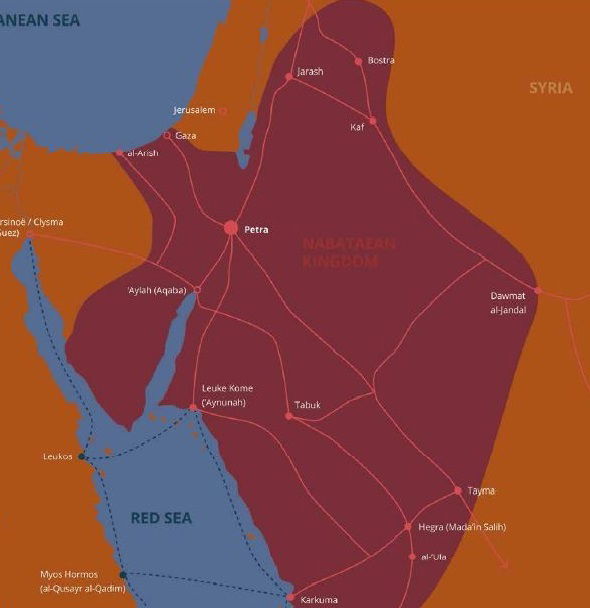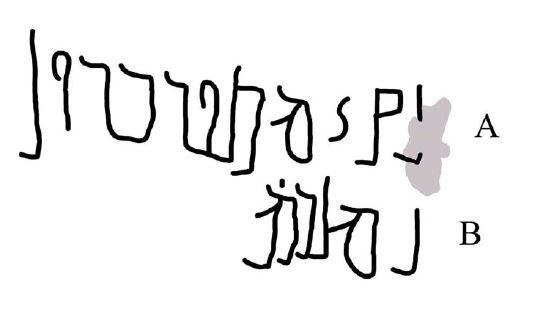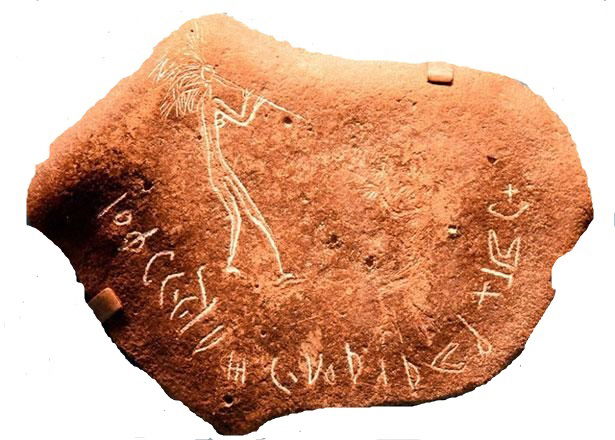
The pre-Islamic North-Arabian scripts represent a broad and complex study field, in regard of the variety of scripts and dialects, the overlapping of societies and cultures, the amount of epigraphic documents, the geographical domain (from Syria to Yemen, from Red Sea to Arabo-Persian Gulf) and finally the large time extend, from the first millennium BC (the oldest are estimated from the 7th century BC) till the middle of the first millennium AD.
Not less than 60 000 inscriptions have been recorded so far and new texts are being discovered at each expedition. What is today the modern Jordan territory belongs to a wider region that scholars name the Ancient North-Arabia. It included the Levant from South Syria till the Northern part of Saudi Arabia, integrating also the flourishing oases of Tabuk, Tayma and Hegra. In the Jordan deserts, we essentially find three types of Semitic scripts: the Safaitic, the Hismaic, which is a variant inside the Thamudic scripts group, and in a lesser proportion the Nabataean script.
Example of Safaitic script | Example of Hismaic script | Example of Nabataean script |
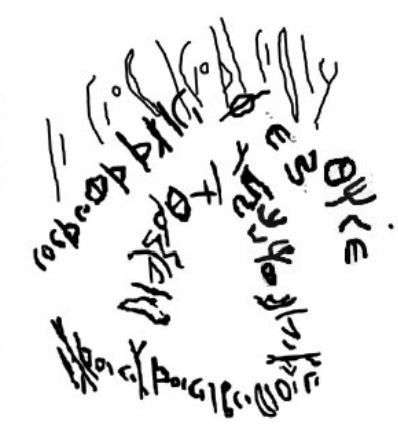 M.Ababneh, R. Harahsheh, ref. below | 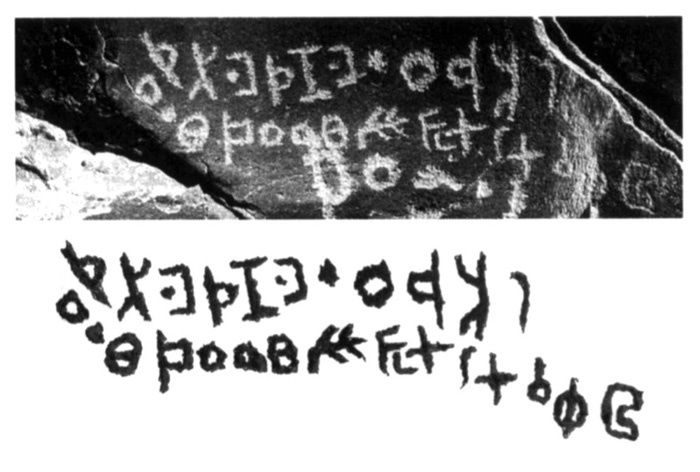 | 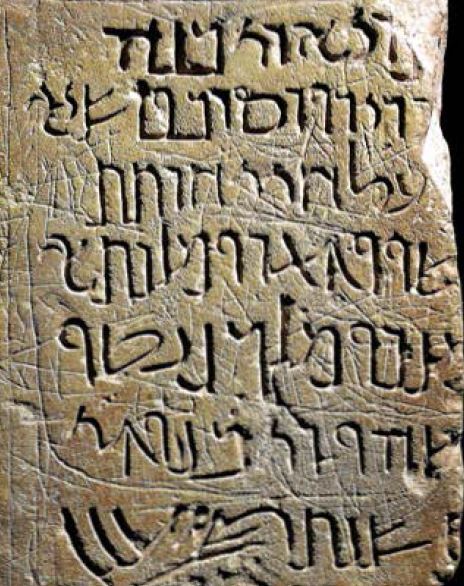 M.Macdonald: Languages, Scripts... ref. below |
The Safaitic, the Hismaic and Thamudic scripts group are used to transcripts Ancient North-Arabian (ANA) dialects related to Old Arabic, with a certain diversity and variations inside the same systems. Within the same geographical domains, we occasionally find the Nabataean script, which derives from the Aramaic alphabet.
The use of an alphabet automatically induce neither the affiliation to a specific social group nor the regular use of the related dialect or language. Names and lineages mentioned in the inscriptions indicate that different groups can use the same alphabet or a same group different or mixed scripts. This dialectal and alphabetical interweaving attests to regular contacts, interconnection and even interdependency between the social groups of different origins.
For example, the following graffito mixes the glyphs from different types of South Arabian scripts. It was moreover discovered in the north-eastern basalt desert, an area we usually find the Safaitic script:
 | 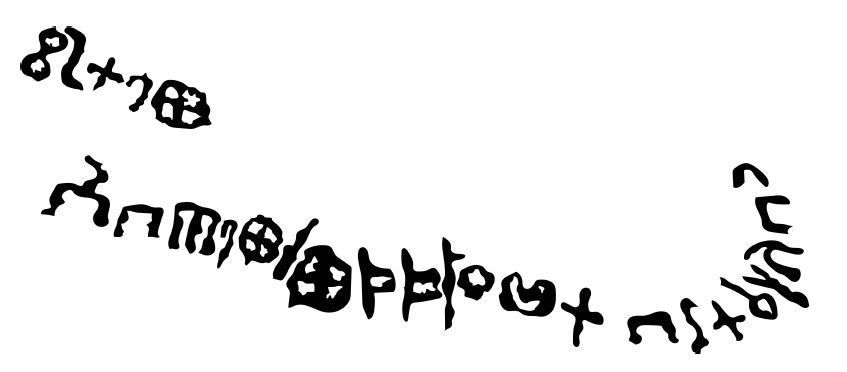 |
P. Stokes art. ref. below
... or here a mix of Hismaic and Safaitic....
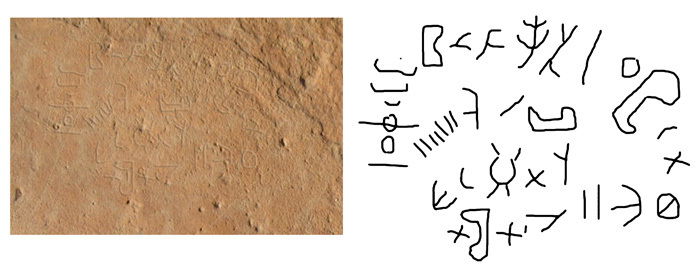 http://mnamon.sns.it/index.php?page=Esempi&id=66&lang=en
http://mnamon.sns.it/index.php?page=Esempi&id=66&lang=en
We find inscriptions (exceptional) where the authors use the Greek alphabet: here below two inscriptions come from the Eastern desert of Jordan. The left one is bilingual Greek and Safaitic. The writers have respected the specificity of the Greek language for noting the lineage (by using the genitive case). However, on the right one, typical local Old-Arabic words are just transliterated with Greek letters, like for example "atawa" meaning "he came" or "dawra" meaning "area", or "wa" meaning "and" , as well as the use of "al" as an article...
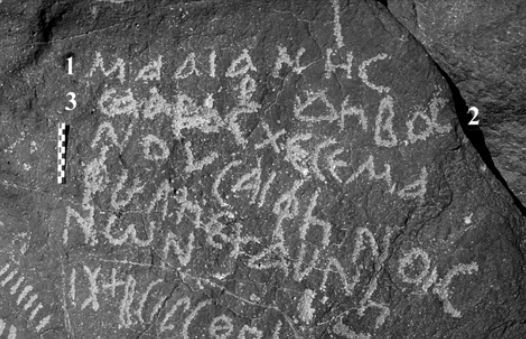 M. Macdonald: Development of Arabic... ref. below | 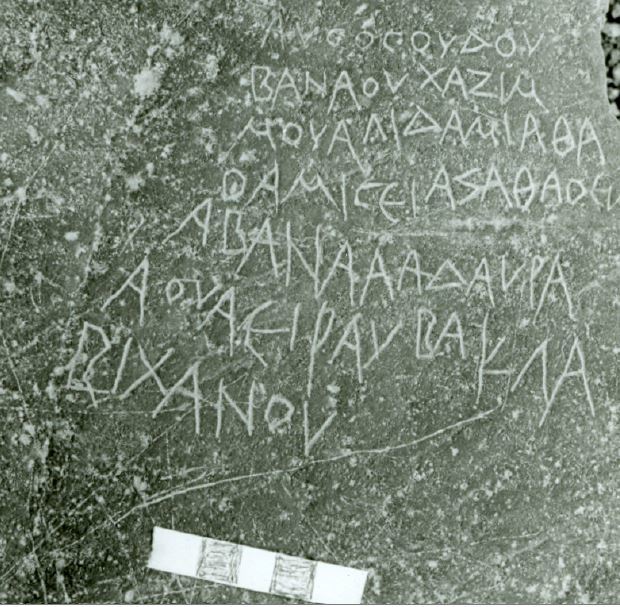 A. Al-Jallad, A. Al-Manaser, ref. below and M. Macdonald's lecture: Identity, Script....ref. below |
... Here an other example of a bilingual graffito in Safaitic and Greek:
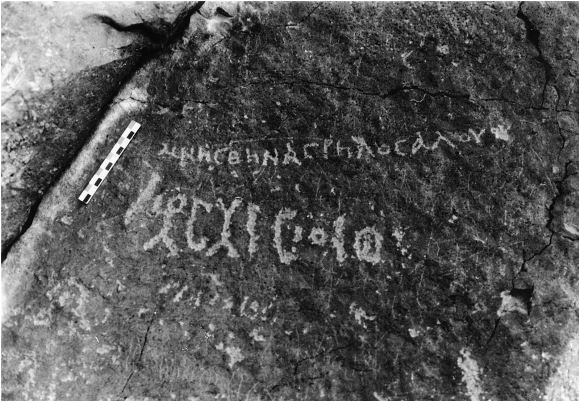 M. Macdonald, Literacy in an Oral Environment, ref. below
M. Macdonald, Literacy in an Oral Environment, ref. below
Writing is used as much by the oases inhabitants as by the nomads. The spread of scripts through the desert seems to indicate a quite good level of literacy among the nomads, although this question is subject to discussion among the scholars. This literacy is probably not the result of a schooling in the nomad societies, but rather of information forwarding and exchanges among the nomads in contact with a wide range of cultures. The nomads themselves were probably somehow vectors.
However, the period concerned by the nomadic inscriptions is limited in the time: it extends roughly between 600 BC and 400 AD (or 700 BC to 500 AD)... a much more restricted bracket than for the petroglyphs. We notice also a geographic limitation: this habit is largely spread over the Harra (the basalt desert from South Syria to Arabia) and Western and Central Arabic Peninsula, but almost absent in the Eastern Arabian desert.
Designing scripts and dialects boundaries would be impossible, as the nomads are traveling long distances and spread their script habits over large areas. Nevertheless, we can distinguish influence zones where specific scripts are majorly represented:
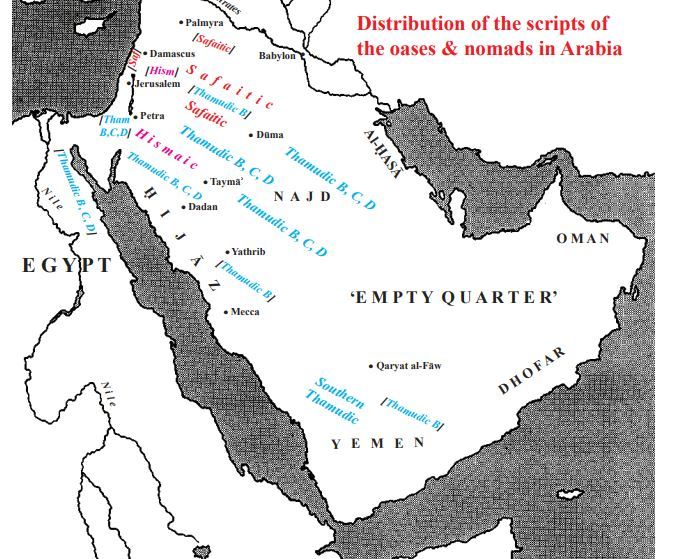 M. Macdonald, N. Nebes, ref. below | This map shows the distribution between the several types of Thamudic scripts, Hismaic and the Safaitic. The Nabataean script, that developed under the Nabataean influence from the 2nd century BC till the Byzantine period, is not mentioned here. The inhabitants of the oasis of Tayma, Dadan and Duma had their own scripts and dialects, respectively the Taymanitic (or Thamudic A), the Dananitic, that did not survive beyond the 1st millennium BC, and the Dumaitic, of which we have so far only three inscriptions. |
It is generally admitted that a proto-alphabet emerged during the 2nd millennium BC. This proto-alphabet evolved in two main scripts families: the Phoenico-Aramaic family on one side, from which the Western alphabet systems as well as the Nabataean script derive, and the South-Semitic family on the other side, also named Arabian scripts, itself subdivided in the Ancient North-Arabian (ANA) group including the Safaitic, Hismaic and Thamudic dialects and South Arabian group used in the South Arabian Peninsula.
From those multiple writing systems, only few survived: all the scripts of the South Arabian group disappeared except an evolution to the Ethiopic alphabet. While the Safaitic, Hismaic and Thamudic were used to transcript Old Arabic dialects, it is the Nabataean script, issued from the Imperial-Aramaic, that evolved to the Arabic alphabet.
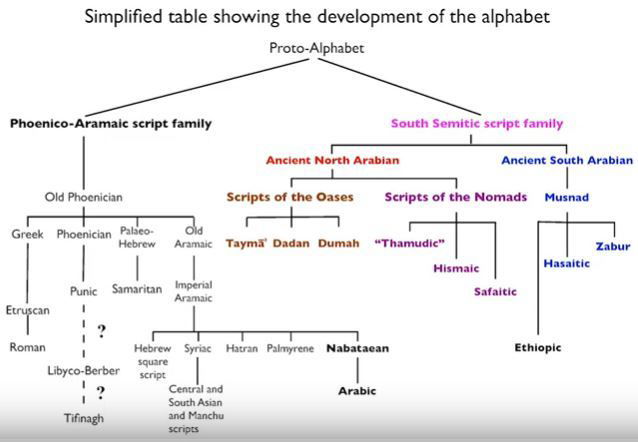
The classification and the denomination of the different writing systems was artificially established by 19th ad 20th centuries scholars. They do not correspond to specific ethnic groups or tribes.
The Safaitic is named following the first discovery of this alphabet on an rock near Safa' (South Syria, near the Jabal Druze).
The Thamudic was confusedly named following the name of a South Arabian tribe that was later discovered not to use this alphabet. However, this denomination was conventionally kept and even tweaked in sub-categories (Thamudic A, B, C, D, E). As Thamudic E, used in the Hisma Basin (Wadi Rum area extending till the North of Arabia), presents dialectal specificities, the scholars finally named it Hismaic.
All those systems are consonantic (abjad). The writing direction is mainly from right to left. Yet, Safaitic and Thamudic show a great adaptability with inscriptions in boustrophedon (going back and forth), vertical, circular or in spiral. (The Nabataean script is always written from right to left).
The support of those scripts are always stones and rocks (except some ostraka with Safaitic inscriptions). Even concerning the Nabataean script, the large majority of documents are stone inscriptions as very few Nabataean papyri survived till now.
Example of a Hismaic inscription written in boustrophedon | Example of a Safaitic inscription written in circle around a sun symbol |
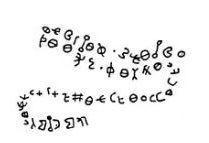 M. Macdonald, Ancient North Arabian, ref. below | 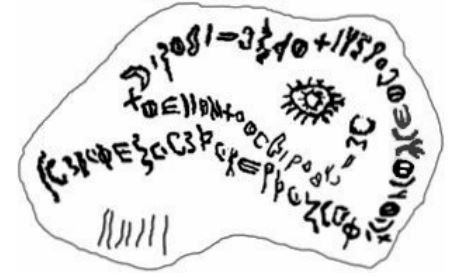 M. Ababneh, R. Harashseh, ref. below |
The purpose of those inscriptions is difficult to establish. At the first look, one could guess that it was a pastime, and probably some graffiti actually were... Pasturing or watching activities require long idle hours and engraving stones with pictures and words could prevent from boredom. However, it appears quickly that many inscriptions have a ritual, religious or funeral dimension, with or without explicit referring to a deity... the omission of the deity address does not automatically implicate that the purpose is not religiously determined. Even in the case of a signature in link with a drawing, the question remains open. In several cases, the depicted animal is dedicated to a deity or explicitly refers to a sacrifice. Indeed, drawing and writing could eventually be part of a sacred and ritual act, maybe assimilate to an offering. Hunting, but also pasturing or just traveling through the desert expose the individuals to many threats and it is common to see authors asking for the deity's protection or assistance. Moreover, the authors often protect their inscriptions by a curse, which suggest that erasing a text is assimilated to a profanation. In the Safaitic domain, the testimonies often refers to difficulties faced in the desert and request security and protection. On the side of Wadi Rum however, we notice a wider range of purposes: many inscriptions look more like a intimate expression, related to life experiences and positive events. In Wadi Rum, people seem less exposed to threats and dangers.
The Safaitic inscriptions:
We mostly find the Safaitic graffiti in the basalt desert of South Syria and Eastern Jordan till North of Saudi Arabia (corpus of about 40 000 texts till now). They can be occasionally found elsewhere (a specimen was even discovered in Italy!). About 40 000 inscriptions have been recorded so far. They are commonly estimated to be contemporary to the Nabataean kingdom, between the 3rd century BC to the 3rd or 4th century AD. Very few texts contain a dating formula that we can understand, as for example reference to the reign of a king or an event we know about, while other dating indication remain obscure to us, as "the year of drought" or "the year of truffles"...
The Safaitic alphabet transcripts a dialect very close to the Old-Arabic and consists in 28 consonants. They are no vowels and no word dividers. Their shapes is remarkably stable, with some variants, but the writing orientation is disorderly. The standardized Safaitic alphabet would be as follows:
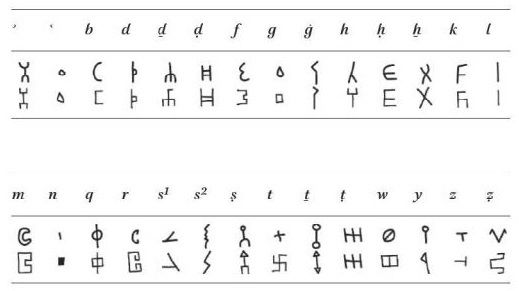 (A. Al-Jallad: http://www.almuslih.com, ref. below) | Some bilingual Greek-Safaitic documents gave to scholars precious information about the pronunciation of this dialect. The language represented by the Safaitic script is not uniform. It consists in variants of the Old Arabic plus or less close to classical Arabic. In this video we can listen Safaitic and appreciate the similarities with Arabic. The structure of the texts show a certain constancy and fix formulas, with repeated features over the time. This suggests that we are in front of a kind of writing tradition. |
A vast majority of Safaitic inscriptions consist in signatures (we mean just a personal name) , from a single name till full lineages (till 14th generations). Signatures are not automatically linked to a drawing. Therefore, it is difficult to interpret the purpose of this practice. For example: "l grmʾl bn gnʾl bn bnt", “By GRMʾL son of GNʾL son of BNT”
Authors often record their actions, speaking about themselves at the 3rd person. We find a large range of activities:
Pasturing is very common: the author built a shelter and claims the ownership. Some lament about the absence of a beloved one, about loneliness, the weather conditions or other difficulties: "... became mad for his beloved forever”, "...pastured (the flock) on vegetation, being alone", " This look-out belongs to S2ddt. A wolf caught his dog", "… he urged on the sheep towards the desert and was on the look-out while sick. O Lt, (grant) relief."
Some graffiti are funeral complaints, as the author buried and grieved a relative (father, child, brother...) and erected a cairn. , for example: “By BHŠ son of GRMʾL son of ʾNʿM, and he slaughtered (sacrificed) for Gadḍaif, and he grieved passionately for his brother”,.. or more dramatic: "By PN and he was devastated by grief on account of his brother Mlṯ who was killed near Hld, so, O Lt and Ds2r, let there be vengeance (nqmt) against one who has taken him away(?)".
Other texts depict rejoicing events or experiences: “ʿBd has (gotten) a daughter”, "By Bkr son of Ḏl. He had sexual intercourse". An inscription composed of three separate graffiti mentions that three brothers gathered for eating truffles...
Some testimonies are relate to raids: "By Ḫld son of Wnnt, so, O Rḍw, help him while he raids in this land". Some pray for booty. Hunting topics are also present: "By ʾLht son of Hʾs1 and he awaited Fate, and, O Rḍw, aid him while constructing ten snares".
Many inscriptions attest to military duties, as patrolling. Many testimonies request security and protection against enemies. Interesting to notice that Nabataeans are frequently mentioned. Bedouin tribes lived alongside the Nabataeans with many economical, political and military interactions between them and likely the Nabataeans relied on their cooperation for the protection of the eastern fringes of their kingdom. We find for example an inscription telling that the author was "on lock-out for the Nabataeans". Some graffiti are particularly interesting as they apparently refer to the annexation of the Nabataea by Rome or insurgency against the Roman occupation, which tends to prove that the subjugation to Rome caused some troubles...: " snt mrdt nbt ʿl ʾl (r)m", the year the Nabataeans rebelled against the people of {Rome}", "snt wsq bn rm nbt", the year of the struggle between Rome and the Nabataeans", "snt trq mk mlk nbt tltn mʾt qtl ʾl rm“ , [in] the year[in which] Mk king of the Nabataeans Nabat smote one hundred [and] thirty warriors of the Romans".
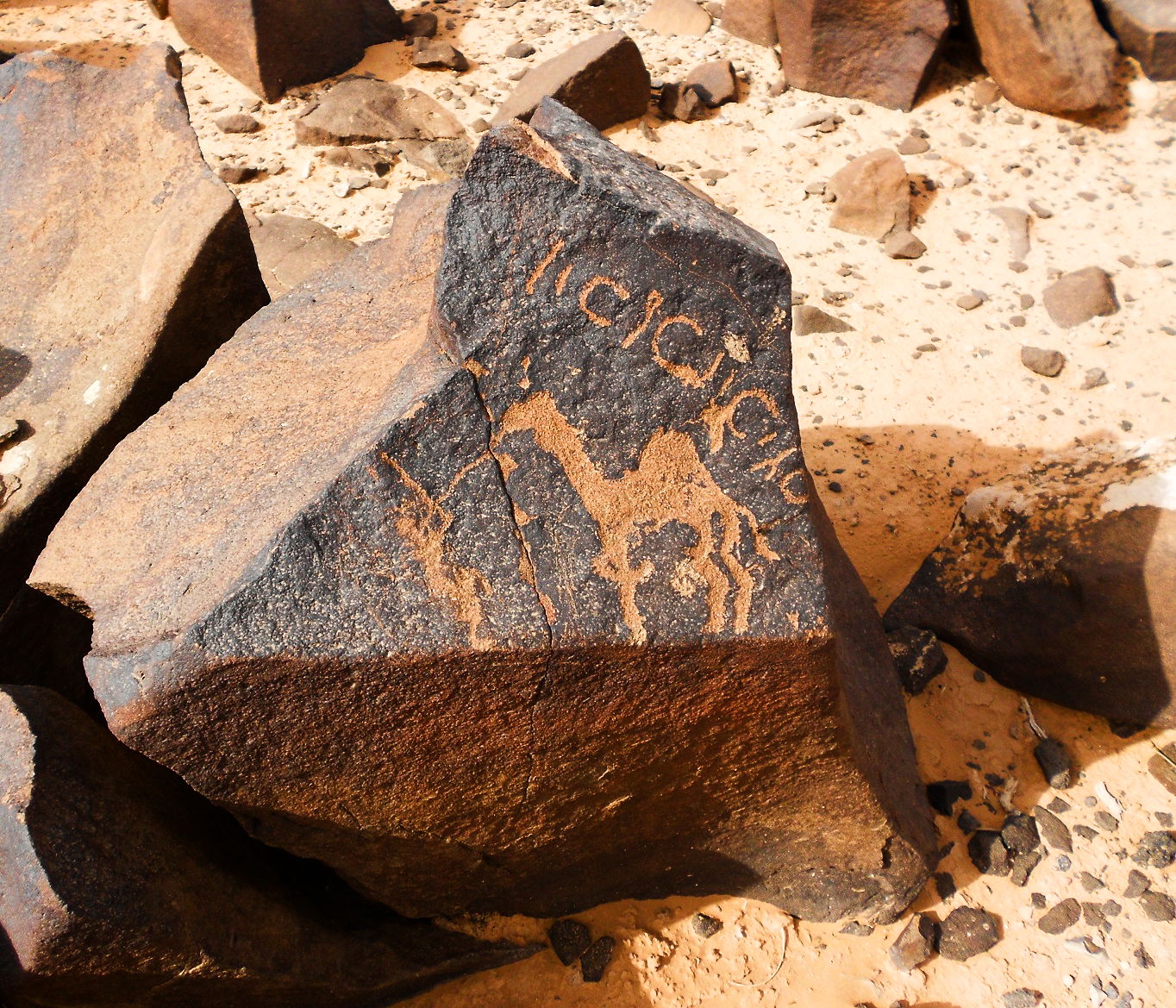 | The most invoked deities are Lt/ʾLt, that some scholars transcribe by Lat or Lath and Rḍw/Rḍy, but altogether about a dozen more deities are known: bʻlsmn “the Lord of Heaven” a deity of which we found two temples in Syria, gdḍf “Gaddaif", meaning "the fortune of ḍf”, a tribal deity well known in the Safaitic inscription. We also meet Dšr, "Dūšarā ", the main deity of the Nabataean pantheon, at the period of Nabataean influence. In general, prays are for peace, security, abundance, protection against illness or misfortune, mercy, relief and sometimes booty. The mention of a sacrifice is common on certain specific places (example below), with the verb ḏbḥ (ḏabaḥa) “he slaughtered (an animal)” that we can translate by "offered a sacrifice to...." when the name of the deity is explicitly mentioned (see examples below). Animals drawings can be an offering to a deity, for example: “By Wqr son of Yʿl are the two camels which have been dedicated to ʾLt and to Rḍw.” |
Curses are common, generally against who might obliterate the inscription (and not without reason, as many inscriptions are found to have been subject to erasure tentative). This habit is plausibly motivated by the sacred value of the inscriptions and the hope that their potential effect will last. We have some graffiti that seem to attest the practice of praying for the person who let his name on the stone. In this case, letting the name on a stone is a chance to be the object of a future invocation or pray. The dedication of animal figures to deities tempts to prove that designs as well as texts had a deep ritual signification. The curses often target the health of the eventual victim, wishing him blindness (most common), dumbness, lameness, mange... or hard conditions in the desert as dearth of pasture, or to be thrown out of the grave once dead.
(Citations and translations are taken from: J. Harjumäki, I. Lindstedt art. , M.Ababneh, R.Harahsheh art. and Z. Al-Salameen, Y. Al-Shdaifat art., ref. below)
Examples of Safaitic inscriptions with transcription and translation
1) Two Inscriptions mentioning a sacrifice, found on the site of Tall ar-Rāhib, close to the Jordano-Syrian border, containing a cairn and other circular structures. The first one (12) alludes to the mourning for a father. The second one (13) invokes the deities of Lat/h and Dūšarā and curse to anyone who would damage the inscription : (photo, transliteration and translation and comments: M. Ababneh, R. Harashseh, ref. below)
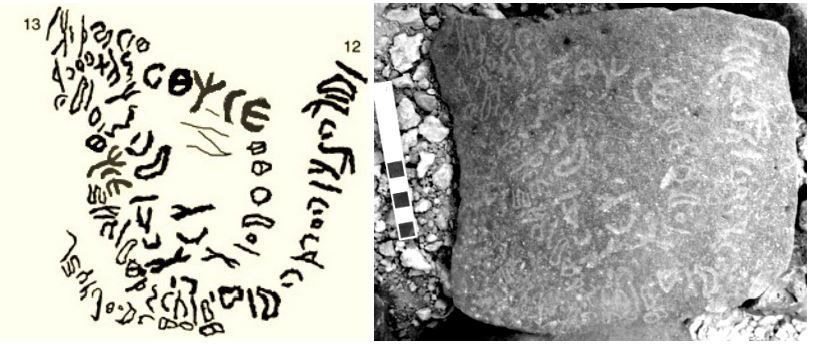
12. l mlk bn khl bn ʿbd bn mlgn bn ʾbslm bn šhr wḏbḥ wwgm ʿl ʾbh
“By MLK son of KHL son of ʿBD son of MLGN son of ʾBSLM son of ŠHR, and he slaughtered and he grieved for his father”.
13. l ʾndf bn wškt bn ʿbd bn mlgn wḏbḥ fhl slm wdšr slm wʿwr m ʿwr hsfr
“ʾNDF son of WŠKT son of ʿBD son of MLGN, and he slaughtered, O Lā(t/h) [grant] peace and Dūšarā [grant] peace and blind him in one eye who (will) obliterate/deface this inscription”.
2) Inscription praying the deities to grant with booty (also from Tall ar-Rāhib) : (photo, transliteration and translation and comments: M. Ababneh, R. Harashseh, ref. below)
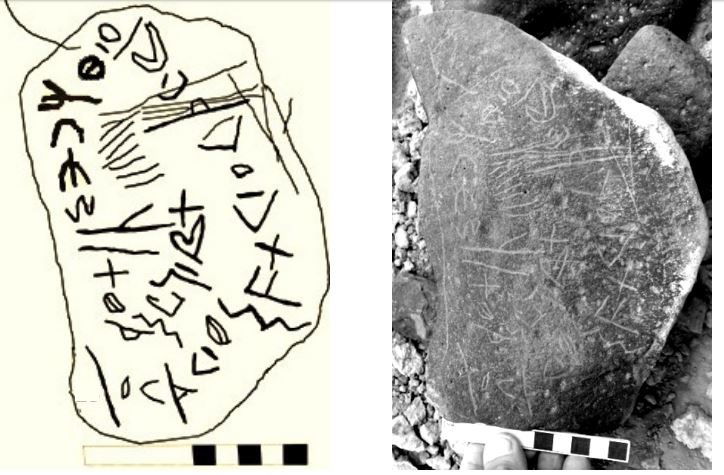
l ʿbd bn wškt bn ʿbd bn mlgn wḏbḥ fhlt wdšr ġnmt
“By ʿBD son of WŠKT son of ʿBD son of MLGN, and he slaughtered, O Lāt and Dūšarā [grant] booty”.
3) Inscription accompanying a scene depicting a group of ostriches and deer hunted by two dogs. (photo, transliteration and translation and comments: M. Alzoubi, S. Al-Maani, H. Al-Qudrah, ref. below)
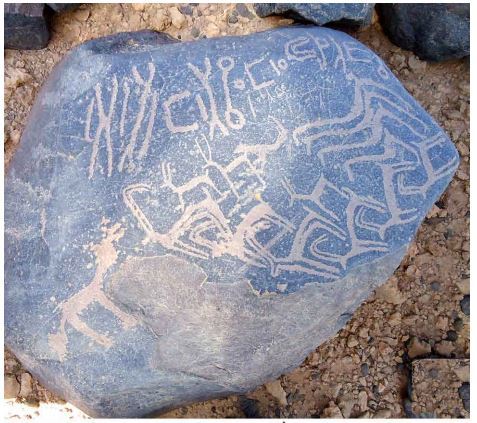 | 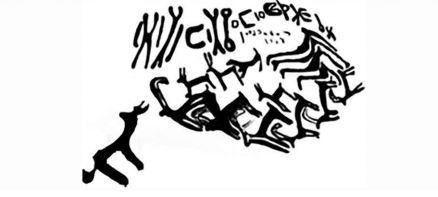 |
l ḫl’l bn’ṯ c bn c md hḥyt
‘These animals belong to Ḫl’l son of ’ Ṯc son of c Md’
4) Inscription from Burqu area, interesting by its reference to the Nabataean king Rabel, probably Rabel II (70 - 106 AD), the last Nabataean sovereign, who transferred the Nabataean capital from Petra to Bosra, and to the name of an prosperous Nabataean city of the Hauran, Slhd: (photo, transliteration, translation and comments: Z. Al-Salameen, Y. Al-Shdaifat art., ref. below)
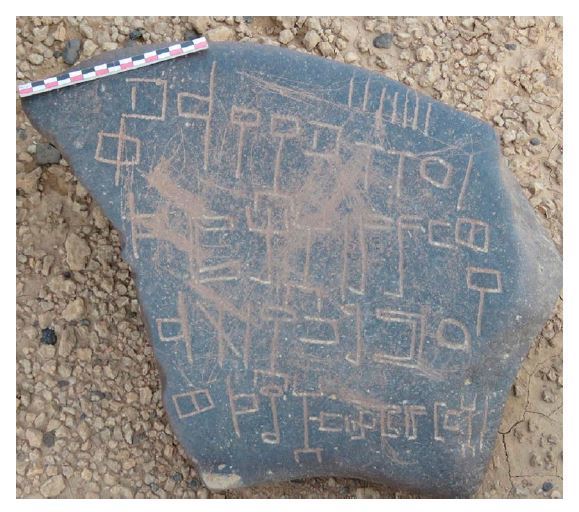 | 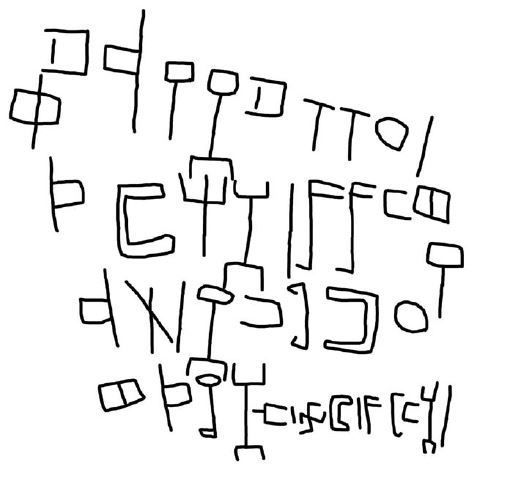 |

The Hismaic inscriptions:
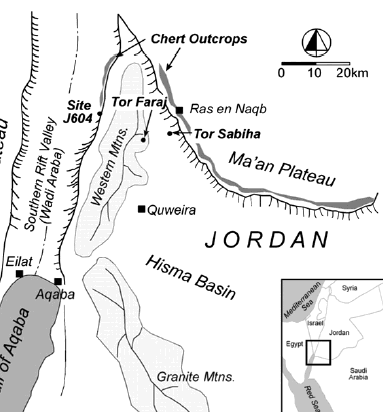 | The Hismaic inscriptions are found in the Hisma basin stretching from Ras En Naqab escarpment to the North-Western Arabian plains. Most of them are from Wadi Rum. The quantity of petroglyphs and graffiti discovered in Wadi Rum is impressive (more than 20 000) and not all have been recorded so far. Beside the Hismaic script, we also find Nabataean, divers Thamudic, Safaitic and Dadanitic scripts. The presence of different scripts, dialects and religious practices in this relatively limited area indicates that Wadi Rum was a cosmopolitan crossroad on the trade routes, as a gateway for the caravans linking Tabuk, Hegra and Tayma to the ports of Ayla (ancient Aqaba) and Gaza, to Petra or to the via Trajana, Bosra and Damascus. Thus Wadi Rum was an intersection between different cultures. |
The Hismaic inscriptions are thought to date from roughly the same period as the Safaitic, an approximate bracket between few centuries BC to few centuries AD. Indeed, they are also contemporary to the Nabataean cultural development. The Hismaic alphabet consists in 28 consonants. It transcripts a distinct dialect with its own orthographic and stylistic conventions. Those specificities leaded the scholars to remove this dialect out of the group of Thamudic scripts, which is anyway a conventional umbrella for gathering diverse type of Arabian indigenous scripts.
The most remarkable feature of the Hismaic script is the representation of the phonemes /g/ and /th/ by signs which, in other South Semitic scripts, have quite different values. The standardized Thamudic alphabet could be tentatively as follows (we find more than one suggestion):
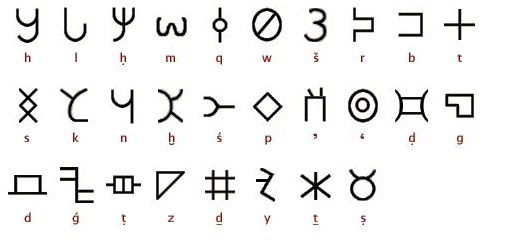
while the Hismaic variant can be observed on the below table:
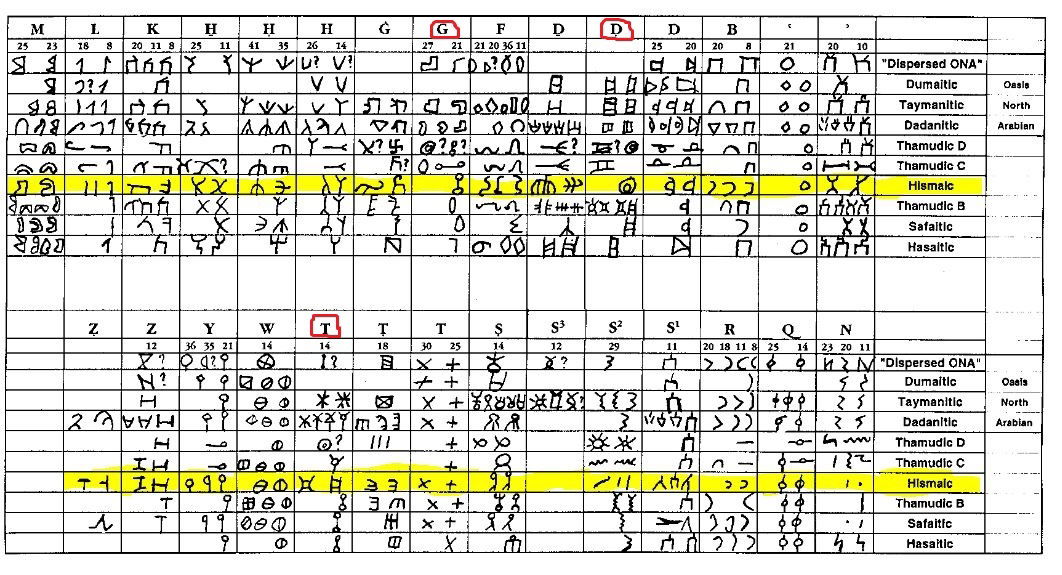 http://krc.orient.ox.ac.uk/ociana/images/script_table.jpg
http://krc.orient.ox.ac.uk/ociana/images/script_table.jpg
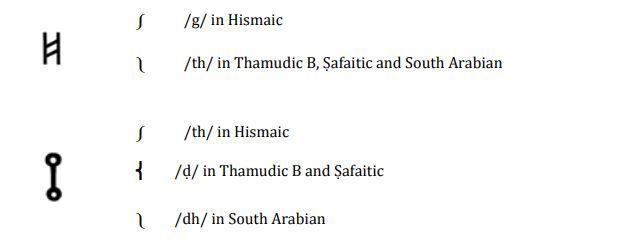 | Moreover, the phoneme /ḍ/ is represented by two concentric circles in Hismaic (occasional in Ṣafaitic, and possible in Thamudic D). |
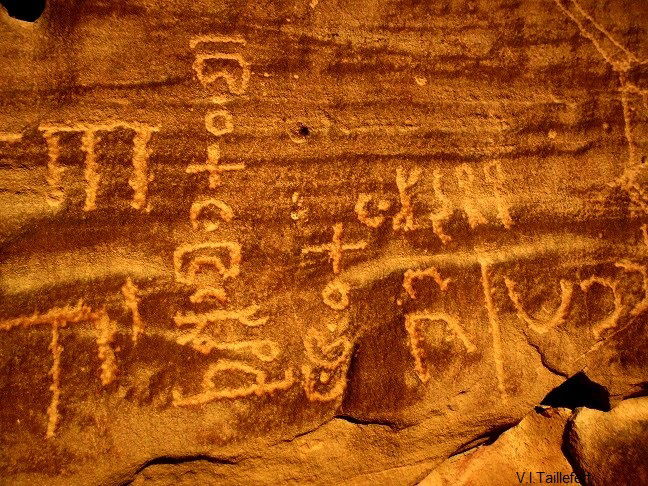 | The writing expression of the Hismaic texts is less rigid than of Safaitic: for example, while the Safaitic texts always start with the preposition "l" (named by the scholars the lam auctoris) meaning "by" or "for" followed by a name, the Hismaic texts show more flexibility and can begin in many different ways. An invocation can start like: “May Lt remember ʾLʿn …”. A narrative text can begin directly with: “Mbʿl loved a young woman.” Signature of adjacent drawings is very common in the Hismaic area and they are written in a more explicit way: "“And PN is the inscriber of the ibex.” Hismaic signatures rarely include genealogy. We find in the Hismaic texts the same topics as in Safaitic, but with an opening on personal experiences and free expression. Beside the references to hunting and worship practices, the Hismaic inscriptions testify about the everyday life, concerns and feelings, in a larger range than Safaitic texts. We find love adventures, love declarations, sexual blustering... "Mbʿl feels much happiness", "Km feels much sickness for Ḥd", "S²mrh loved a young woman and a young girl, two seductresses", "Rhs had sex with ʿZz (or: a loved one) and made love repeatedly"... |
In supplications to divinities, we see sometimes the name of Lh or ʾLh, which may refer to the name of Allah, at that time not so common. We also notice in the Hismaic domain explicit mentions of mercy and compassion, based on the roots rḥm and ḏkr, as we find later in the Islamic Arabic graffiti. In the same line, an invocatory formula of the Hismaic texts with "May the deity remember (ḏkr/ḏkrt) something or someone..." becomes common in the later Islamic invocations. For example, "ḏkr ʾlh s1lm" "May ʾLh remember S1lm" or "ḏkrt ʾlt kll s1[ṭ]rt" "May ʾLt remember every wish/inscription".
(Citations and translations are taken from: J. Harjumäki, I. Lindstedt art.., ref. below)
Examples of Hismaic inscriptions with transcription and translation
1) This first inscription from Wadi Rum is a rare example of a text carved by a woman and presents the first attestation in Hismaic dialect of the feminine pronominal form. Only seven, or possibly 8 Hismaic graffiti are signed by a woman: (photo, transliteration and translation and comments: J. Norris, ref. below)
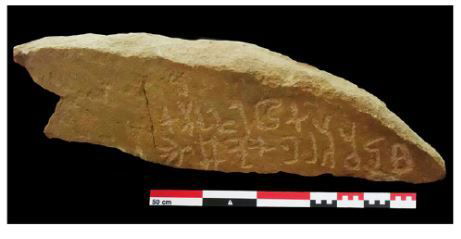 | 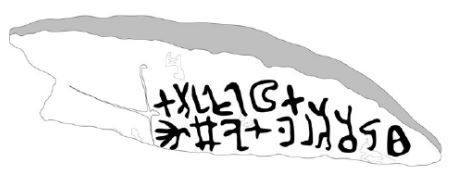 |
wfṣʾl bnt gṯ
ḏt ʾl glmt
And Fṣʾl daughter of Gṯ
of the lineage of Glmt
2) This inscription is part of a corpus of 8 graffiti found in the Wadi Hafir, a valley descending from Ras En-Naqab escarpment toward Al-Disseh area. This group of graffiti presents bilingual inscriptions in Hismaic and Nabataean scripts and languages. The below inscription has its Nabataean counterpart on the left side: (photo, transliteration, translation, comments: H.Hayajneh art., ref. below)
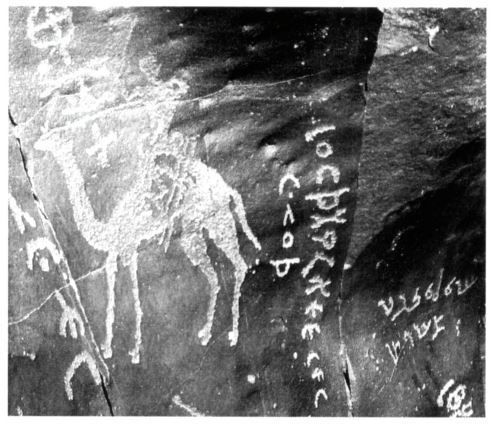 | 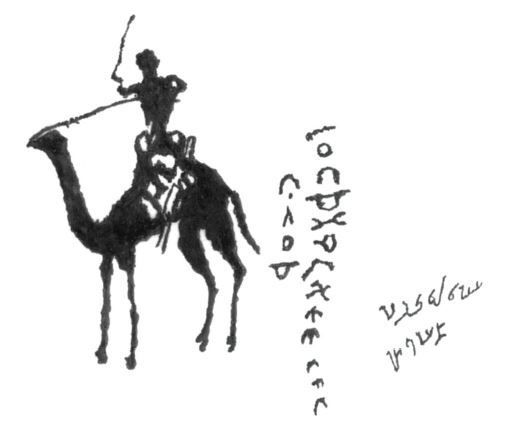 |
Hismaic text: | Nabataean text: |
  |  |
3) This inscription is written in a loop starting from left of the upper line: (transliteration, translation and comment: G. King Corpus, ref. below)
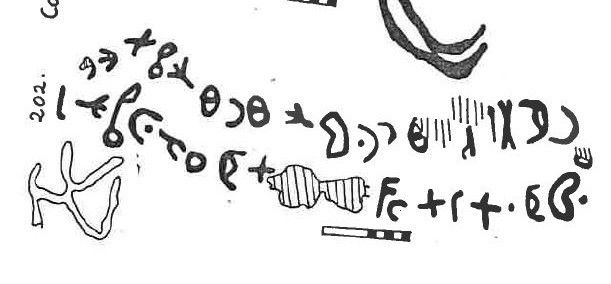
l ḥg bn s¹ʿdt [w] [ḏ]krt lt ndmn ʿbdʾl(ʾ)[ḥ]wr bn mḥwr w ḥg ḫṭṭ
By ḥg son of s¹ʿdt and may lt remember our boon companion ʿbdʾl(ʾ)[h]wr son of
mḥwr and ḥg is [the] inscriber
The Nabataean desert inscriptions:
Nabataean influence zone at the maximal extension | The Nabataean script in itself is not a nomad script, but we find a certain number of inscriptions in the deserts, especially in Wadi Rum where people from diverse origins were in close contact. The Nabataean script does not belong to the South Semitic group but derives from the Aramaic script, that was largely spread in the whole Near and Middle East especially since the 5th century BC. Aramaic, originate from Syria, was a kind of international language and script that was in use, with variants, from Egypt to Mesopotamia. Whereas many people included in the Nabataean kingdom probably spoke an Old Arabic dialect, there are still discussions among scholars to identify the language of the Nabataean elite. In all cases, for writing, they used a variant of the Aramaic script. We do not know if this fact proceeds from a logic connection between the script and their natural language, or, in case they spoke a kind of Old Arabic dialect, from a deliberate choice from their elite, or a practical habit that they assimilated through their trade experience and the common uses at that time. Another interesting fact is that the Nabataean script constitutes the link to the modern Arabic alphabet. Effectively, at a certain period, the Nabataean scribes started linking the letters together, which leaded to the cursive Arabic script we know today. (For more details, see this page) |
The Nabataean script started developing during the 2nd century BC (some inscriptions are even earlier). It spread together with the extension of the Nabataean power and the cultural influence. The writing direction is exclusively from right to left. The standardized Nabataean script is the following:
 https://nabataea.net/explore/culture_and_religion/write/
https://nabataea.net/explore/culture_and_religion/write/
In the Eastern desert, far from the urban centers, Nabataean graffiti are rare. In Wadi Rum, the Nabataean texts are mainly, and unsurprisingly, found near the sacred places as the Ain Shallala temple and the open-air sanctuary located in a grotto in the upper rocks, where several sources rise from, and Al-Ruways temple. At Ain Shallala sanctuary, the graffiti are connected with cultic practices. We find there 27 inscriptions, all in Nabataean except 2 in Greek. Most inscriptions mention only the writer’s and ascendant's name, with the famous "remembered be" formula that will become common in the early Arabic inscriptions. Several of those testimonies come from workers involved in building, as masons, sculptors, architects, plasterers, who seem to constitute a group (maybe related to the construction of temple below?). Ain Shallala temple also shows a certain number of dedicatory inscriptions, in Nabataean but also in Greek, Latin, Hismaic and Minaic. This mix of languages and scripts shows that people with different cultural backgrounds and knowledge used to attend the sanctuary, bringing with them diversified religious practices: a large proportion of "Western" script is found temple while the open-air sanctuary in the rocks witnesses a predominance of Nabataean worshipers. A distinction is also noticed in the way to represent the divinity: stylized carved betyls in the grotto and the anthropomorphic statue in the temple.
Examples of Nabataean inscriptions with transcription and translation
1) A double inscription from the Eastern Desert of Jordan (Burqu area) showing specificities from the Safaitic dialect while written with the Nabataean script, especially the lam auctoris (see above) as an introduction formula, very common in Safaitic but exceptional in Nabataean texts: (photo, transcription, translation and comments: Z. Al-Salameen, Y. Al-Shdaifat art., ref. below)
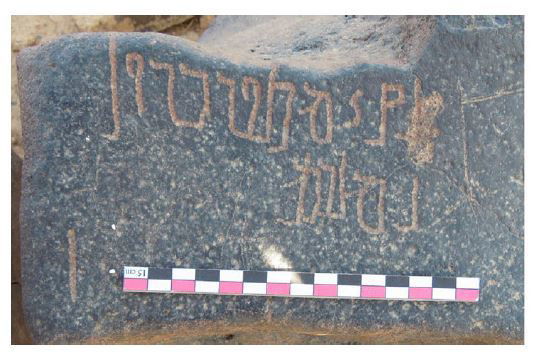 |
|
A. Lqymtw dkrwn (in proper Aramaic, it should be: dkrwn qymtw)
Remembrance of Qymtw
B. Lmlkt
By Mlkt
2) Inscription from the Eastern Desert of Jordan (Burqu area) and shows Aramaic specificities. The writer's father name is well attested in Umm Al Jimal, but not elsewhere in the Nabataea, and seems to be an "Aramaisation" of a Safaitic tribe name. The son's name however is well attested in other Nabataean inscriptions... maybe the example of a local family that assimilated the Nabataean influence: (photo, transcription, translation and comments: Z. Al-Salameen, Y. Al-Shdaifat art., ref. below)
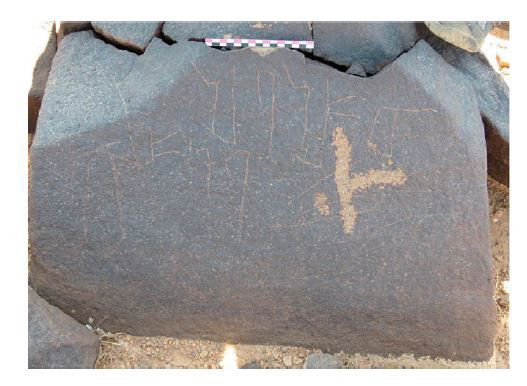 |  |

ʾšdw son of Ytwr Peace
3) An interesting inscription discovered in Wadi Rum in the 1950s, of which we have only the drawing. It testifies to a camel's burial. It could be related to a ritual attested in Arabia consisting in burying a scarified camel at the proximity of human tombs: (photo, transliteration, translation, comments: (H.Hayajneh: The Nabataean Camel Burial.. art., ref. below)
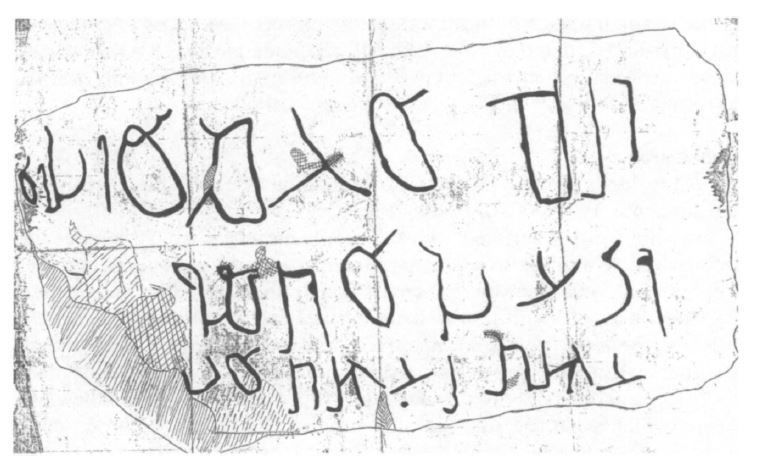
1) dnh 'gm'wblw'
2) dy 'bd "tmw [br]
3) rh(n/lr)ht (n/l)t >b[h]
1) This is the (grave) tumulus and the (camel) burial
2) 4- 3) which "TMW [son of] rH(N/L)T has built for rH(N/L)T [his] father
4) Two graffiti from Ain Shallala grotto, written by masons: (photo, translation and comments: A.-K. Reiger art., ref. below)

References:
Ahmad Al-Jallad: Safaitic, http://www.almuslih.com/Library/Jallad,%20A%20al%20-%20%20Safaitic%20Grammar.pdf
Ahmad Al-Jallad: What is Ancient North Arabian? https://www.academia.edu/33917069/Al-Jallad._2018._What_is_Ancient_North_Arabian?email_work_card=view-paper
Ahmad Al-Jallad, Ali Al-Manaser: New Epigraphical form Jordan I: A Pre-Islamic Arabic inscirption in Greek letter and a Greek inscription from North-Eastern Jordan, https://www.academia.edu/21041949/Arabian_Epigraphic_Notes_Volume_1_2015_
Ahmad Al-Jallad, Ali Al-Manaser: New Epigraphica from Jordan II: three Safaitic-Greek partial bilingual inscriptions, https://www.academia.edu/30943914/Arabian_Epigraphic_Notes_2_2016_?email_work_card=view-paper
Anna-Katharina Rieger: Loose Bonds and Porous Boundaries among Mobile People as Religious Agents in the Greco-Roman Arabian Desert https://www.researchgate.net/publication/314681842_Loose_Bonds_and_Porous_Boundaries_among_Mobile_People_as_Religious_Agents_in_the_Greco-Roman_Arabian_Desert
Geraldine King: Early North Arabian Hismaic. A preliminary description based on a new corpus of inscriptions from the Ḥismā desert of southern Jordan and published material Volume I, http://krc.orient.ox.ac.uk/aalc/images/documents/mcam/early_north_arabian_hismaic.pdf
Glenn Corbett : The Wadi Hafir Petroglyph Survey: Shedding New Light on Thamudic Inscriptions https://www.acorjordan.org/2015/03/10/the-wadi-hafir-petroglyph-survey-shedding-new-light-on-thamudic-inscriptions-by-glenn-corbett-s/
Hani Hayajneh: Ancient North Arabian-Nabataean bilingual inscriptions from southern Jordan, https://www.academia.edu/27753772/Ancient_North_Arabian-Nabataean_bilingual_inscriptions_from_southern_Jordan
Hani Hayajneh: The Nabataean Camel Burial Inscription from Wadi Ram /Jordan, https://www.academia.edu/27412314/The_nabataean_camel_burial_inscription_from_wadi_ram_Jordan_Based_on_a_drawing_from_the_archive_of_professor_John_strugnell_
Jerome Norris: A woman’s Hismaic inscription from the Wadi Ramm desert: AMJ 2/J.14202 (Amman Museum) https://onlinelibrary.wiley.com/doi/epdf/10.1111/aae.12086
Jouni Harjumäki, Ilkka Lindstedt: The Ancient North Arabian and Early Islamic Arabic Graffiti, https://www.academia.edu/28761420/The_Ancient_North_Arabian_and_Early_Islamic_Arabic_Graffiti_A_Comparison_of_Formal_and_Thematic_Features
Mahdi Alzoubi, Sultan Al-Maani, Hussein Al-Qudrah: Safaitic Inscriptions and Possible Hunting Scenes from the North-Eastern Badiya, Jordan https://eis.hu.edu.jo/deanshipfiles/pub103637023.pdf
Michael Macdonald, Norbert Nebes: Ancient Arabia: A brief history and time-line http://krc.orient.ox.ac.uk/resources/publications/macdonald/Ancient%20Arabia%20a%20Brief%20History%20and%20Time-Line.pdf
Michael Macdonald: The Development of Arabic as a Written Language http://krc.orient.ox.ac.uk/resources/ociana/publications/ancient_arabia_written_word.pdf
Michael Macdonald: Language, Scripts, and Uses of Writting among the Nabataeans http://krc.orient.ox.ac.uk/resources/ociana/publications/nabataeans.pdf
Michael Macdonald: Ancient North Arabian https://www.academia.edu/4421414/Ancient_North_Arabian
Michael Macdonald: Literacy in an Oral Environment, http://krc.orient.ox.ac.uk/resources/ociana/publications/literacy.pdf
Michael Macdonald: Clues to How a Nabataean May have Spoken, from a Hismaic Inscription, https://www.academia.edu/37399737/Clues_to_How_a_Nabataean_May_have_Spoken_from_a_Hismaic_Inscription
Michael Macdonald, Geraldine King: Thamudic Definition, http://krc.orient.ox.ac.uk/aalc/images/documents/mcam/mcam_thamudic_definition.pdf
Mohammad Ababneh, Rafe Harahsheh: Sacrifice in the Safaitic Inscriptions in the Light of New Evidence https://pdfs.semanticscholar.org/7db2/e446166d33528dd41d0ce2f019c5c0b90fec.pdf?_ga=2.157496314.1513242386.1586877908-838837577.1586877908
Phillip Stokes: A new and unique Thamudic Inscription from northeast Jordan, https://www.academia.edu/30943914/Arabian_Epigraphic_Notes_2_2016_?email_work_card=view-paper
Zeyad Al-Salameen, Younis Al-Shdaifat, Rafe Harahsheh: Nabataean echoes in al-Ḥarrah: New evidence in light of recent field work https://www.researchgate.net/publication/323941031_Nabataean_echoes_in_al-Harrah_New_evidence_in_light_of_recent_field_work
Exhibition Catalog: The “Mysterious and Innovative Nabataeans“ exhibition http://www.enpicbcmed.eu/sites/default/files/medina_catalogue_nabataean.pdf
https://www.jordantimes.com/news/local/yemen-naples-scholar-explores-reach-nabataean-civilisation
http://krc.orient.ox.ac.uk/ociana/index.php/documentation
http://mnamon.sns.it/index.php?page=Esempi&id=66&lang=en
https://www.wadirumprotectedarea.com/petroglyphs-rock-art-wadi-rum
Lectures:
Ahmad Al-Jallad: Digital Approaches to Ancient Literacy: The Case of Safaitic, https://www.youtube.com/watch?v=q7p4TYe-VMo
Kaelin Groom: Community Engagement in Rock Art Management in Wadi Rum https://www.acorjordan.org/2017/09/27/community-engagement-in-rock-art-management-in-wadi-rum-an-acor-usaid-schep-video-lecture-by-dr-kaelin-groom/
Michael Macdonald: Identity, script, and the uses of writing in pre-Islamic Arabia, https://www.youtube.com/watch?v=O2-pVJN9G7s
Robert Hoyland: https://www.youtube.com/watch?v=PkxZfpUqtCk

